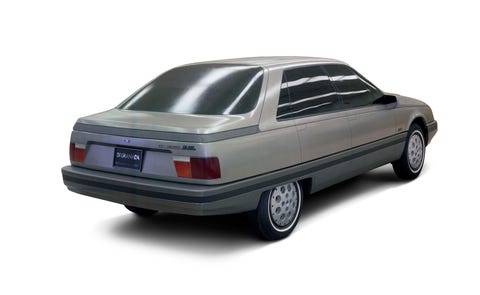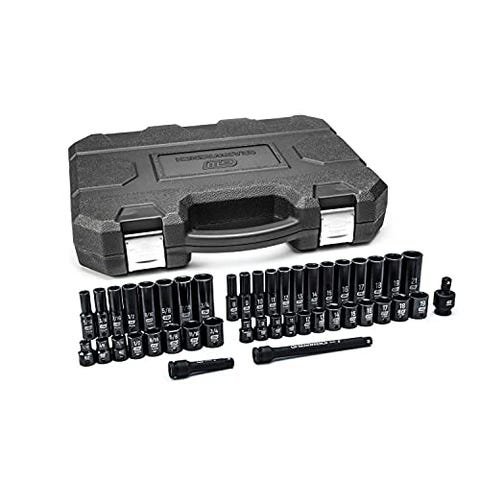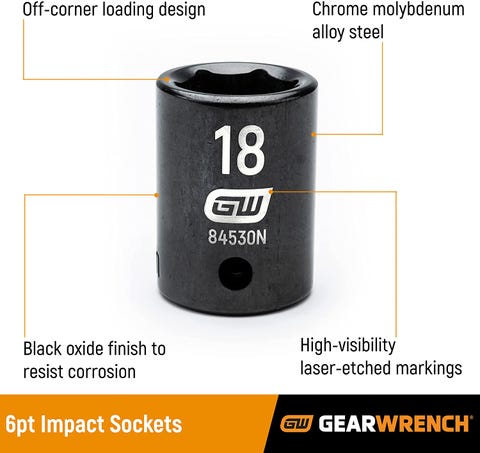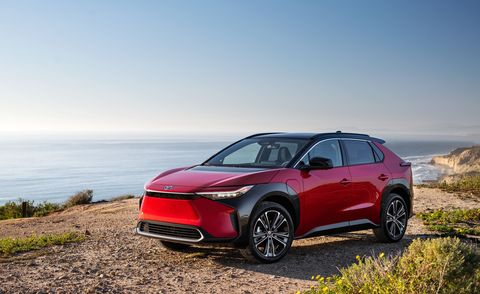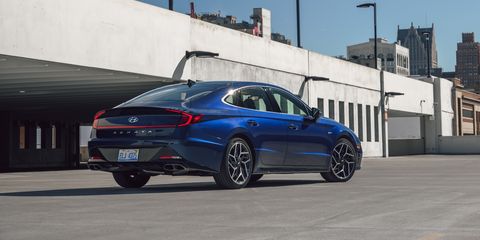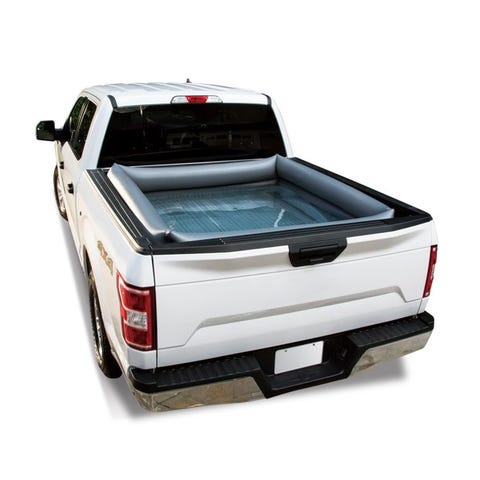20,000-Mile Update
After spending most of Michigan’s winter season in relative hibernation, our long-term 2021 Hyundai Sonata N Line has finally muscled past the 20,000-mile mark. About halfway to that milestone, the hot-rod mid-size sedan headed west to sunny Southern California, collecting nearly 2500 miles on the cross-country trip from Car and Driver‘s headquarters in Ann Arbor to technical editor Dan Edmunds’s driveway in Santa Ana.
Before our Sonata N Line made the westward journey, its logbook had accumulated several comments since the 10,000-mile update. Several of the newer notes reiterated prior grousing about the eight-speed dual-clutch automatic transmission that’s exclusive to the N Line and has garnered its share of complaints for its low-speed behavior. Most staff members have praised the responsive nature of the N Line’s 290-hp turbocharged 2.5-liter inline-four, but deputy video editor Carlos Lago and senior reviews editor Mike Sutton both had uncomplimentary opinions about its power delivery. “This feels more uncouth every time I’m in it,” said Sutton.
Michael SimariCar and Driver
While we obviously have mixed opinions about the powertrain’s overall cohesiveness, most everyone agrees that the Sonata N Line would be better with all-wheel drive to help regulate traction. Whether they’ve considered it fun or frustrating, everyone who has driven the feisty front-drive sedan is familiar with its virtually unavoidable wheelspin. Once up to speed, though, the complaints about burning rubber and the klutzy transmission are forgotten. Buyer’s Guide deputy editor Rich Ceppos complimented the N Line’s exhaust presence, and road test editor Becca Hackett said she was impressed by the car’s value and fun factor. She also noted that the we fitted last November worked wonderfully in ugly weather on her daily commute. Plus, we’re now currently averaging 28 mpg—a 1-mpg increase over our previous average and the EPA combined rating.
Michael SimariCar and Driver
We replaced the winter rubber with the standard-issue P Zero all-seasons at exactly 13,694 miles, right before the car left Michigan for California. As soon as the Sonata N Line reached its new home in Orange County, we took it in for its second scheduled service at 16,194 miles. Once again, this was covered under Hyundai’s complimentary maintenance program that includes basic maintenance for the first three years or 36,000 miles. The dealer performed an inspection and oil-and-filter change, and replaced the in-cabin air filter. We elected not to have the engine air filter replaced because it wasn’t time, and we skipped the tire rotation since it had been done as part of the pre-road-trip tire swap.
Regardless of what rubber it wears, the Sonata N Line’s starchy ride quality has been a sticking point among our staff. Is it too stiff or justifiably firm? Neither side will likely change its position over the final 20,000 miles, but Edmunds might be able to help readers who want a more nuanced opinion. After all, he’s previously had suspension development jobs for two different automakers (just peep his bio). He writes, “The ride is nicely damped and well buttoned down, even on the pretty wavy asphalt that you typically find in the Pacific Northwest. There’s no float at all, and it has just the right amount of rebound damping.” Edmunds does point out that the rear suspension, which has slightly firmer springs as part of the N Line treatment, feels constrained over expressway expansion joints, a road condition that’s far more prevalent in places where they have a real winter.
Michael SimariCar and Driver
When it isn’t overwhelmed by torque steer, the wheel provides authentic feedback that’s absent on lesser Sonata models. The steering’s positive on-center feel and progressive buildup through sweeping corners both drew praise from Edmunds. Less praiseworthy was the steering column’s limited telescoping adjustment and some missing infotainment features. Not only was he disappointed that the stereo doesn’t have a tuning knob, but he questioned the value of the wireless charging pad when Apple CarPlay and Android Auto still require wired connections.
The only greater annoyance Edmunds mentioned was the N Line’s push-button shifter. Stands to reason: Unlike the ongoing debate over the ride quality and powertrain behavior, the staff is united in its disdain for our long-termer’s unintuitive push-button shifter arrangement. And now we have just under 20,000 miles left to argue about and evaluate the most powerful sedan Hyundai has ever built.
Months in Fleet: 9 months Current Mileage: 20,121 miles
Average Fuel Economy: 28 mpg
Fuel Tank Size: 15.9 gal Observed Fuel Range: 440 miles
Service: $0 Normal Wear: $0 Repair: $0
Damage and Destruction: $0
Specifications
Specifications
2021 Hyundai Sonata N Line
Vehicle Type: front-engine, front-wheel-drive, 5-passenger, 4-door sedan
PRICE
Base/As Tested: $34,305/$34,474
Options: carpeted floor mats, $169
ENGINE
turbocharged and intercooled DOHC 16-valve inline-4, aluminum block and head, port and direct fuel injection
Displacement: 152 in3, 2497 cm3
Power: 290 hp @ 5800 rpm
Torque: 311 lb-ft @ 1650 rpm
TRANSMISSION
8-speed dual-clutch automatic
CHASSIS
Suspension, F/R: struts/multilink
Brakes, F/R: 13.6-in vented disc/12.8-in vented disc
Tires: Pirelli P Zero All Season
245/40R-19 94W M+S
DIMENSIONS
Wheelbase: 111.8 in
Length: 192.9 in
Width: 73.2 in
Height: 56.9 in
Passenger Volume: 104 ft3
Trunk Volume: 16 ft3
Curb Weight: 3549 lb
C/D TEST RESULTS: NEW
60 mph: 5.2 sec
100 mph: 12.7 sec
1/4-Mile: 13.8 sec @ 104 mph
130 mph: 23.6 sec
Results above omit 1-ft rollout of 0.3 sec.
Rolling Start, 5–60 mph: 5.7 sec
Top Gear, 30–50 mph: 3.1 sec
Top Gear, 50–70 mph: 3.9 sec
Top Speed (C/D est): 155 mph
Braking, 70–0 mph: 183 ft
Roadholding, 300-ft Skidpad: 0.85 g
C/D FUEL ECONOMY
Observed: 28 mpg
Unscheduled Oil Additions: 0 qt
EPA FUEL ECONOMY
Combined/City/Highway: 27/23/33 mpg
WARRANTY
5 years/60,000 miles bumper to bumper
10 years/100,000 miles powertrain
7 years/unlimited miles corrosion protection
5 years/unlimited miles roadside assistance
3 years/36,000 miles scheduled maintenance
C/D TESTING EXPLAINED
10,000-Mile Update
Michael SimariCar and Driver
The front-wheel-drive 2021 Hyundai Sonata N Line that joined our long-term fleet at the end of last summer averaged roughly 2300 miles per month during its first three months in our care. However, as soon as November hit and the N Line’s standard all-seasons were swapped out for a set of , its mileage accumulation slowed to about 1000 miles a month. As much as many of us enjoy driving Hyundai’s performance-oriented family sedan, it’s not our first pick when snow blankets our local thoroughfares.
It’s a given that wintertime in Michigan will generally curtail the number of long road trips our staff takes. The all-wheel-drive alternatives in our fleet, such as our gas-guzzling Ram 1500 TRX, have received a lot more love lately. The N Line, on the other hand, is racking up miles at a similar pace to our mid-engine Corvette Stingray and rear-drive BMW M3 long-termers. But could our Sonata’s lull in activity also stem from us growing cold to its excessive wheelspin, firm ride, and sometimes clunky dual-clutch automatic transmission? All three matters have been mentioned in its logbook since our last update, though the context of those comments wasn’t entirely negative.
Michael SimariCar and Driver
Even before we signed up for 40,000 miles with the most powerful front-drive sedan Hyundai has ever produced, we knew that this car has a tendency to torque-steer and spin its front tires. Love it or hate it, that trait is to be expected when only the N Line’s front axle must handle both steering duties and harnessing the 290 horsepower and 311 pound-feet of torque from its 2.5-liter turbo-four. The sensation can be entertaining or exhausting, depending on its pilot’s disposition and the driving scenario. “Accelerating with any real zest requires quite the dance with your right foot, but it is fun, nonetheless,” wrote road warrior Jacob Kurowicki. He was less enthused at times with the eight-speed automatic, which occasionally stumbles at low speeds but is otherwise quick and precise in operation.
Buyer’s guide deputy editor Rich Ceppos believes that the Sonata N Line’s rubber-burning antics would be less obnoxious if it had a limited-slip differential. An electronic diff is standard equipment on Hyundai’s sportier Elantra N and the Veloster N models, so why not this similarly powerful Sonata? According to Hyundai, it’s because this isn’t a full-blown N model like those two other cars, but we still think it deserves the upgrade. The N Line’s rather stiff ride also has divided our staff on whether this car’s setup is too aggressive for a volume model. Some drivers have deemed the ride uncomfortable, while others compare its buttoned-down behavior to our dearly departed 2020 BMW M340i long-termer. Ceppos leans toward the latter opinion: “The ride always seems choppy for the first couple of miles, but my inner ear gets used to it, and for the rest of the trip it feels fine.”
Michael SimariCar and Driver
As one of two staff members who has recently taken the Sonata N Line on a longer journey, Ceppos complimented its excellent lane-centering feature, part of Hyundai’s semi-autonomous drive mode called Highway Driving Assist. Our travels also have helped maintain the N Line’s 27-mpg average fuel economy, equaling its EPA combined estimate. Similarly, a previous test of another Sonata N Line on our 75-mph highway route returned an EPA-matching 33 mpg—impressive for this car’s hot-rod-like personality—even if our 2018 Honda Accord Sport long-termer was thriftier at the pump still.
Although the Sonata N Line’s popularity has (likely only temporarily) waned, it remains problem-free. The first scheduled service visit happened at 8333 miles and was covered under Hyundai’s complimentary maintenance program that includes basic maintenance for the first three years or 36,000 miles. Included in that initial pit stop was an inspection, oil-and-filter change, and a tire rotation, plus the fixing of a loose-fitting fuel pipe per a recall. Now we just need to talk the dealer into installing a limited-slip diff to help with the N Line’s frenzied wheelspin.
Months in Fleet: 7 months Current Mileage: 11,169 miles
Average Fuel Economy: 27 mpg
Fuel Tank Size: 15.9 gal Observed Fuel Range: 420 miles
Service: $0 Normal Wear: $0 Repair: $0
Damage and Destruction: $0
N-troduction
Michael SimariCar and Driver
Calling the Hyundai Sonata N Line a modern-day muscle car is a surefire way to get accused of automotive heresy. After all, it’s just a family sedan with a hotter engine, a stiffer suspension, a flashy body kit, and some red interior accents, right? Well, yeah, but the original GTO was just a Pontiac Tempest with a high-output V-8, upgraded chassis and drivetrain components, and various visual distinctions. The point isn’t to directly compare the souped-up Sonata to the legendary GTO. They’re obviously incomparable. Philosophically, though, they’re cut from the same cloth, only they exist in different eras.
The New York Times reports that, in 2020, millennials bought more new cars than baby boomers for the first time ever. Coincidentally, that aligns with the rapid expansion of Hyundai’s N performance subbrand, which makes many of its mainstream models more emotionally stimulating. The 201-hp Elantra N Line and the 286-hp Elantra N are prime examples. To see if the Korean automaker can teach a younger generation that cars can be fun—but mainly to see how the new N-branded version of Hyundai’s mid-size sedan holds up over the course of 40,000 miles—we welcomed a 2021 Sonata N Line to our long-term fleet.
Michael SimariCar and Driver
Unlike the compact Elantra, the Sonata’s performance peaks with the N Line. It’s the only trim level that features a turbocharged 2.5-liter inline-four and an eight-speed dual-clutch automatic transmission. The engine makes 290 horsepower and 311 pound-feet of torque. That’s nearly 100 ponies and 130 pound-feet more than the Sonata’s 2.5-liter four-cylinder base engine. With all that power solely feeding the front axle, there’s more squealing from the N Line’s front tires than a barnyard full of pissed-off pigs. Even in the default Normal drive mode, we found ourselves involuntarily burning rubber when leaving stops with relatively mild throttle inputs. As a result, we’ll be monitoring our test car’s tread wear. Every N Line rolls on intricately designed multi-spoke 19-inch wheels that can be wrapped with Continental Premium Contact 6 summer tires as a $200 option, but ours came with the standard Pirelli P Zero all seasons.
We regret not upgrading to the Continentals, because the N Line we track-tested with them outperformed our long-termer on the standard Pirellis. On summer tires, the N Line stopped from 70 mph in a short 152 feet; it needed 183 feet on the all-seasons. Likewise, the stickier tires helped the N Line generate a notable 0.93 g on our 300-foot skidpad versus 0.85 g. At least the tires on our long-term Sonata barely affected its acceleration times. It launched to 60 mph in 5.2 seconds and cleared the quarter-mile in 13.8 ticks at 104 mph. We’ll have to see if we can close the 0.2-second gap versus the summer-tire-equipped N Line during its exit test.
Michael SimariCar and Driver
Still, the differences between the Sonata N Line and the rest of the lineup go deeper than tire options, an exclusive powertrain, and excessive wheelspin. The engine and transmission mounts are stiffer to better handle the higher torque output. Along with larger brake rotors all around, Hyundai says the calipers are revised to work with the bigger discs and upgraded brake pads. The N Line also has thicker anti-roll bars and features specially tuned dampers and slightly firmer rear springs. Its steering ratio is quicker, too, and the electric motor that assists the steering system is relocated from the column to the rack to improve the feel. The net result is a car that handles really well and drives more cohesively than the regular version. The downside is that the N Line’s ride is considerably stiffer.
Apart from the optional summer tires—which aren’t available on its corporate sibling, the Kia K5 GT—there are virtually no options to distinguish your N Line from your neighbor’s. Selecting the audacious Glowing Yellow paint might be one, especially since it has been dropped for the 2022 model year. Our 2021 example wears no-cost Stormy Sea (deep blue) paint and $169 carpeted floor mats that raise its $34,305 base price to $34,474 as tested. The N Line comes standard with a 12-speaker Bose stereo, a full suite of driver assists, heated front seats, passive entry, a panoramic sunroof, and wireless phone charging. Plus, it has a digital gauge cluster and a 10.3-inch touchscreen infotainment system with built-in navigation, as well as Apple CarPlay and Android Auto.
Michael SimariCar and Driver
So far, we’ve racked up just nearly 7000 miles. Most of that was around our headquarters in southeast Michigan, but we’ve also traveled to the state’s Upper Peninsula and into Ontario, Canada. The N Line has a combined EPA rating of 27 mpg, which is what we’re averaging. The early logbook comments praise the car’s chassis tuning and transmission calibration. However, some staffers have called its interior drab. There are quibbles about the push-button shifter and that the plastic behind the door handles isn’t as nice as the surrounding trim. The driver’s seat height is also unnaturally high, leaving some of our noggins uncomfortably close to the microsuede headliner.
With thousands of miles left to go, we’ll ultimately decide if the sportiest Sonata excites us or exhausts us. And hopefully along the way we’ll also find out if the N Line can inspire this generation the way the Pontiac GTO once did past generations.
Months in Fleet: 3 months Current Mileage: 6969 miles
Average Fuel Economy: 27 mpg
Fuel Tank Size: 15.9 Observed Fuel Range: 420 miles
Service: $0 Normal Wear: $0 Repair:$0
Damage and Destruction: $0
Specifications
Specifications
2021 Hyundai Sonata N Line
Vehicle Type: front-engine, front-wheel-drive, 5-passenger, 4-door sedan
PRICE
Base/As Tested: $34,305/$34,474
Options: carpeted floor mats, $169
ENGINE
turbocharged and intercooled DOHC 16-valve inline-4, aluminum block and head, port and direct fuel injection
Displacement: 152 in3, 2497 cm3
Power: 290 hp @ 5800 rpm
Torque: 311 lb-ft @ 1650 rpm
TRANSMISSION
8-speed dual-clutch automatic
CHASSIS
Suspension, F/R: struts/multilink
Brakes, F/R: 13.6-in vented disc/12.8-in vented disc
Tires: Pirelli P Zero All Season
245/40R-19 94W M+S
DIMENSIONS
Wheelbase: 111.8 in
Length: 192.9 in
Width: 73.2 in
Height: 56.9 in
Passenger Volume: 104 ft3
Trunk Volume: 16 ft3
Curb Weight: 3549 lb
C/D TEST RESULTS: NEW
60 mph: 5.2 sec
100 mph: 12.7 sec
1/4-Mile: 13.8 sec @ 104 mph
130 mph: 23.6 sec
Results above omit 1-ft rollout of 0.3 sec.
Rolling Start, 5–60 mph: 5.7 sec
Top Gear, 30–50 mph: 3.1 sec
Top Gear, 50–70 mph: 3.9 sec
Top Speed (C/D est): 155 mph
Braking, 70–0 mph: 183 ft
Roadholding, 300-ft Skidpad: 0.85 g
C/D FUEL ECONOMY
Observed: 28 mpg
Unscheduled Oil Additions: 0 qt
EPA FUEL ECONOMY
Combined/City/Highway: 27/23/33 mpg
WARRANTY
5 years/60,000 miles bumper to bumper
10 years/100,000 miles powertrain
7 years/unlimited miles corrosion protection
5 years/unlimited miles roadside assistance
3 years/36,000 miles scheduled maintenance
C/D TESTING EXPLAINED
A car-lover’s community for ultimate access & unrivaled experiences.
This content is created and maintained by a third party, and imported onto this page to help users provide their email addresses. You may be able to find more information about this and similar content at piano.io

